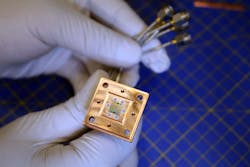Quantum computers hold promise for tackling complex problems beyond the reach of today's most powerful supercomputers—from designing new drugs and materials to breaking sophisticated encryption. But these machines operate on the principles of quantum mechanics, which makes them hypersensitive to environmental disturbances and various sources of errors. To perform calculations accurately, the fundamental building block quantum bits (a.k.a. qubits) are often cooled to temperatures near absolute zero and initialized to a well-defined ground state.
A team of researchers led by Professor Simone Gasparinetti at Chalmers University of Technology in Sweden and Professor Nicole Yunger Halpern at the U.S. National Institute of Standards and Technology and the University of Maryland made a significant breakthrough by developing a novel quantum refrigerator that can autonomously cool superconducting qubits to record-low temperatures (see Fig. 1). This invention, reported in Nature Physics,1 demonstrates the first practical application of a quantum thermal machine that may pave the way for more-reliable and less error-prone quantum computations.
The need for a clean quantum slate
Qubits, unlike classical bits that are either in logical state 0 or 1, can exist in a superposition of both states simultaneously. This allows quantum computers to explore a vast number of possibilities concurrently, which can be exploited in quantum algorithms and grant them a computational advantage. But before any computation, qubits need to be initialized in a fiduciary state, often associated with the lowest-energy state, corresponding to the logical state “0”. Any uncertainty in its initial state is an error that can compound to even more errors down the line and derail the calculation. The closer qubits are to their ground state, the more accurate and reliable the subsequent computations will be. One way to set the qubits to their ground states is to cool them extremely well to drain them of any energy needed to be in the excited (logical) state “1”.
Superconducting qubits offer one of the most promising platforms for building a quantum computer. They are cooled to extremely low temperatures using dilution refrigerators, reaching a base temperature below 10 mK. But the qubits themselves are significantly hotter, typically around 50 mK, and cooling them down further becomes exceedingly difficult. This temperature leaves a small but non-negligible likelihood that qubits remain in an excited state, a source of significant error for quantum computing. The quantum refrigerator demonstrated by Gasparinetti, Yunger-Halpern, and coworkers offers a way to reset the qubits to the ground state more effectively by cooling them down to 22 mK, preparing a cleaner slate for computations.
Harnessing heat to create cold
A remarkable feature of the quantum refrigerator is its mechanism: it uses a heat flow within the system to achieve cooling, operating autonomously, without the need for continuous external control. This kind of refrigerator is known as a quantum absorption refrigerator. It consists of three superconducting “qudits”—generalizations of qubits with more than two energy levels. These qudits are engineered to interact with one another and their respective thermal environments.
One qudit is coupled to a warmer environment, acting as a hot thermal bath, to provide the energy to drive the refrigeration process. This hot bath excites this “hot” qudit. The second qudit is coupled to a colder environment, serving as a cold thermal bath, where heat can be expelled. The third qudit is the target qubit that needs to be cooled and reset to the ground state.
A precisely engineered three-body interaction between the qudits drives the refrigeration process: a quantum of energy from the hot qudit and a quantum of energy from the target qubit are concurrently transferred to the cold qudit, which then dissipates this energy into the cold thermal bath. This process continues until the target qubit reaches a record-low effective temperature of 22 mK. This temperature corresponds to a high probability (99.97%) of the target qubit being in its ground state—improving on current state-of-the-art qubit reset protocols which “only” achieve 99.8 to 99.9% success probability. While this improvement may seem modest, such gains are significant in the battle against errors in quantum computing.
The experiment was initially designed as a proof of concept, but the research team realized that the machine outperforms all existing qubit-reset protocols and cools the qubit to record-low temperatures.
The significance of autonomous quantum machines
The fact that this useful quantum refrigerator operates autonomously is a significant novelty. Most cooling systems require external energy input like the electricity powering a conventional refrigerator. An autonomous machine, however, draws its power directly from the temperature difference between thermal baths. This not only simplifies the operation, but also potentially reduces the energy and control resources needed to maintain the delicate quantum state of the qubits. This demonstration, the research team points out, marks the first autonomous quantum thermal machine performing a practically useful task. The team also envisions the different-temperature layers of the dilution refrigerator could be used as resourceful thermal baths during computations.
Quantum analogy with typical cooling
The concept of an absorption refrigerator might sound familiar from the macroscopic world. A traditional absorption refrigerator, often used in recreational vehicles or off-grid applications, also uses a main heat source (like propane combustion or solar energy) to drive a cooling cycle, typically involving a refrigerant and an absorbent. The quantum absorption refrigerator operates on a similar principle, using a “hot” quantum system to extract heat from another “cold” quantum system, albeit through fundamentally quantum mechanical interactions rather than classical thermodynamics of fluids.
Just as real-world absorption refrigerators can provide cooling in situations where electricity is scarce, perhaps future iterations of quantum absorption refrigerators could offer practical and localized cooling solutions within complex quantum processors. This could be relevant in other kinds of quantum devices that require sophisticated thermal management strategies.
A cooler quantum future
This is the first demonstration of how quantum thermodynamics, the study of energy and heat at the quantum level, can be harnessed to solve practical challenges in quantum computing. Classical thermodynamics emerged in the 18th century and facilitated the industrial revolution, but so far quantum thermodynamics hasn’t been very practical.
This autonomous quantum refrigerator represents a milestone in bridging the gap between theoretical concepts in quantum thermodynamics and practical applications in quantum technology. This work may inspire further exploration into the potential of autonomous quantum machines for tackling other challenges in quantum computing and beyond.
REFERENCE
- M. A. Aamir et al., Nat. Phys., 21, 318–323 (2025); https://doi.org/10.1038/s41567-024-02708-5.
Aamir Ali
Aamir Ali is a research specialist in the Department of Microtechnology and Nanoscience at Chalmers University of Technology (Gothenburg, Sweden).
Simone Gasparinetti
Simone Gasparinetti is an associate professor in the Department of Microtechnology and Nanoscience at Chalmers University of Technology (Gothenburg, Sweden).

